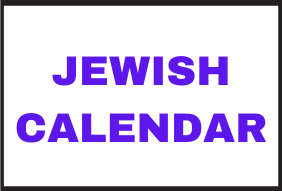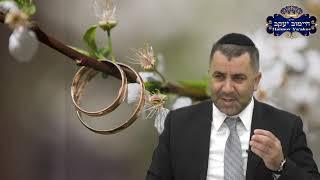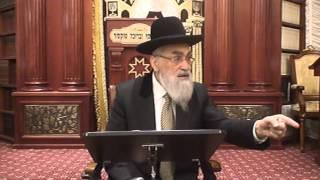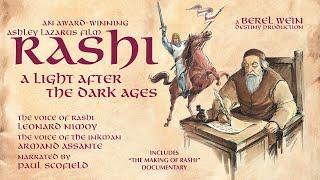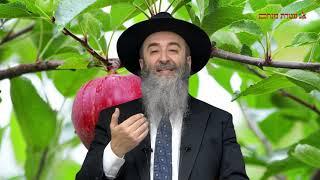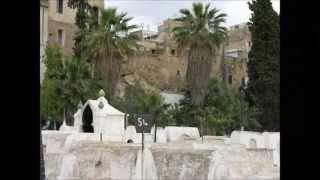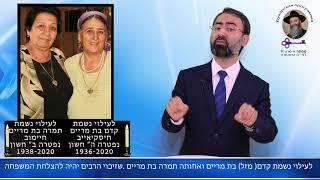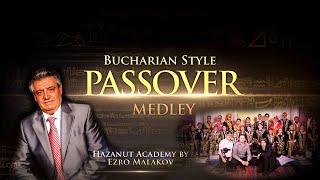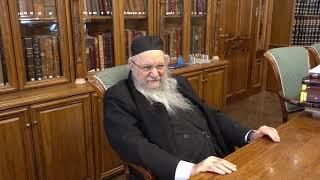Problems playing the video? Click Here to reload
Watch Videos: Random | New | Popular
All Essays | Report Video
|
Share Video
- Buy Us a Coffee -
Rabbi Dovid Zauderer
TO DONATE - https://www.canadahelps.org/dn/24741
.
SHABBAT FOR BEGINNERS: Sanctifying the Sabbath the 7th Day of Rest, as commanded in the Jewish Torah.
Shabbat (also known as "Shabbos" or the "Sabbath") is the centerpiece of Jewish life, and has been so since the infancy of our nation. According to the Talmud, Shabbat is equal to all the other commandments. Shabbat is so central to Jewish life that the term shomer Shabbat (Shabbat observer) is synonymous with “religious Jew” in common parlance.
Shabbat is a day of rest and celebration that begins on Friday at sunset and ends on the following evening after nightfall. Let’s have a look at the history, importance and observances of this day.
We read in the Book of Genesis that G d created the world in six days and rested on the seventh. The sages say that on that day, G d createdmenuchah,rest, without which sustained creativity would be impossible.
After G d took the Children of Israel out of Egypt in the year 2448, He taught them about the Shabbat: working for six days and resting on the seventh. Shabbat is also one of the 10 Commandments that G d transmitted at Sinai several weeks after the exodus. Thus, Shabbat commemorates both the creation of the world and G d’s intervention in world affairs when he took His nation out of slavery.
Throughout the 40 years that our ancestors wandered in the desert, nourishing mannawould rain down from heaven, except on Shabbat. But no one went hungry—extra rations would fall on Friday, so that everyone would have more than enough for the holy day.
The Torah is very brief about the observance of the day, telling us that no work is to be done and no fires are to be kindled. But rabbinic tradition coupled with careful study of the Torah’s texts yields a wealth of information, much of which is found in the Talmudic tractate aptly named Shabbat.
Our sages tell us that the Shabbat is a “queen,” whose regal presence graces every Jewish home for the duration of the Shabbat day. For this reason, we scrub our bodies, dress our finest and make sure our homes are in tip-top shape on Friday afternoon. According to the Talmud, we actually receive a special additional soul every Shabbat.
The prophet Isaiah foretells great delight that comes as a reward “if you restrain your foot because of the Sabbath, from performing your affairs on My holy day, and you call the Sabbath a delight, the holy of the L rd honored, and you honor it by not doing your wonted ways, by not pursuing your affairs and speaking words.”
Shabbat is so special that even our choice of words, comportment, and the items that we touch must be consistent with this holy day. This includes the admonition not to handle items known as muktzeh, which have been set aside because they generally have no use within the Shabbat lifestyle.
Light Candles
Since we do not light fires on Shabbat, our sages declared that every Jewish home should have candles lit before the onset of the Shabbat, so that the evening be peaceful and festive. It is customarily the woman of the house who kindles these lights. The Lubavitcher Rebbe, Rabbi Menachem Mendel Schneerson of righteous memory, encouraged girls as young as three years old to light as well. The candles must be lit at least 18 minutes before sunset and should be placed near where the Shabbat meals will take place. A special blessing is said after the lighting.
Wine and Dine
The Torah commands us to “remember the Sabbath day to sanctify it.” The sages understand this to mean that we must verbally declare the Sabbath a holy day, so on Friday night we say a special prayer over wine in a ritual known as Kiddush (sanctification). (A truncated kiddush is recited again the following day).
After kiddush, Shabbat is celebrated with a sumptuous feast. Make sure to have three large meals on Shabbat: one on Friday night, one the next day, and one smaller one in the late afternoon.
The meals begin with two whole loaves of bread, which remind us of the double portion of manna that fell every Friday. Before we break bread, we wash in a specially prescribed manner.
Typical European-Jewish Shabbat fare includes gefilte fish, chicken soup, kugels and other favorites, but the Shabbat meals really can feature whatever you feel is festive and delicious. During the daytime meal, we customarily eat something warm that has been sitting on a low flame (or other heat source) since the onset of Shabbat, such as the traditional stew of beans, barley, potatoes and meat known as cholent. Note: There are many laws about cooking on Shabbat, so make sure you prepare your cholent correctly.
The meal is a delight for the soul as well. Aside from the physical enjoyment of the feast, the Shabbat meal often includes heart warming stories, songs and Torah thoughts so that the meal is a delight for the soul as well.
Shabbat description courtesy of http://www.chabad.org/library/article_cdo/aid/633659/jewish/What-Is-Shabbat.htm
in English
TO DONATE - https://www.canadahelps.org/dn/24741
.
SHABBAT FOR BEGINNERS: Sanctifying the Sabbath the 7th Day of Rest, as commanded in the Jewish Torah.
Shabbat (also known as "Shabbos" or the "Sabbath") is the centerpiece of Jewish life, and has been so since the infancy of our nation. According to the Talmud, Shabbat is equal to all the other commandments. Shabbat is so central to Jewish life that the term shomer Shabbat (Shabbat observer) is synonymous with “religious Jew” in common parlance.
Shabbat is a day of rest and celebration that begins on Friday at sunset and ends on the following evening after nightfall. Let’s have a look at the history, importance and observances of this day.
We read in the Book of Genesis that G d created the world in six days and rested on the seventh. The sages say that on that day, G d createdmenuchah,rest, without which sustained creativity would be impossible.
After G d took the Children of Israel out of Egypt in the year 2448, He taught them about the Shabbat: working for six days and resting on the seventh. Shabbat is also one of the 10 Commandments that G d transmitted at Sinai several weeks after the exodus. Thus, Shabbat commemorates both the creation of the world and G d’s intervention in world affairs when he took His nation out of slavery.
Throughout the 40 years that our ancestors wandered in the desert, nourishing mannawould rain down from heaven, except on Shabbat. But no one went hungry—extra rations would fall on Friday, so that everyone would have more than enough for the holy day.
The Torah is very brief about the observance of the day, telling us that no work is to be done and no fires are to be kindled. But rabbinic tradition coupled with careful study of the Torah’s texts yields a wealth of information, much of which is found in the Talmudic tractate aptly named Shabbat.
Our sages tell us that the Shabbat is a “queen,” whose regal presence graces every Jewish home for the duration of the Shabbat day. For this reason, we scrub our bodies, dress our finest and make sure our homes are in tip-top shape on Friday afternoon. According to the Talmud, we actually receive a special additional soul every Shabbat.
The prophet Isaiah foretells great delight that comes as a reward “if you restrain your foot because of the Sabbath, from performing your affairs on My holy day, and you call the Sabbath a delight, the holy of the L rd honored, and you honor it by not doing your wonted ways, by not pursuing your affairs and speaking words.”
Shabbat is so special that even our choice of words, comportment, and the items that we touch must be consistent with this holy day. This includes the admonition not to handle items known as muktzeh, which have been set aside because they generally have no use within the Shabbat lifestyle.
Light Candles
Since we do not light fires on Shabbat, our sages declared that every Jewish home should have candles lit before the onset of the Shabbat, so that the evening be peaceful and festive. It is customarily the woman of the house who kindles these lights. The Lubavitcher Rebbe, Rabbi Menachem Mendel Schneerson of righteous memory, encouraged girls as young as three years old to light as well. The candles must be lit at least 18 minutes before sunset and should be placed near where the Shabbat meals will take place. A special blessing is said after the lighting.
Wine and Dine
The Torah commands us to “remember the Sabbath day to sanctify it.” The sages understand this to mean that we must verbally declare the Sabbath a holy day, so on Friday night we say a special prayer over wine in a ritual known as Kiddush (sanctification). (A truncated kiddush is recited again the following day).
After kiddush, Shabbat is celebrated with a sumptuous feast. Make sure to have three large meals on Shabbat: one on Friday night, one the next day, and one smaller one in the late afternoon.
The meals begin with two whole loaves of bread, which remind us of the double portion of manna that fell every Friday. Before we break bread, we wash in a specially prescribed manner.
Typical European-Jewish Shabbat fare includes gefilte fish, chicken soup, kugels and other favorites, but the Shabbat meals really can feature whatever you feel is festive and delicious. During the daytime meal, we customarily eat something warm that has been sitting on a low flame (or other heat source) since the onset of Shabbat, such as the traditional stew of beans, barley, potatoes and meat known as cholent. Note: There are many laws about cooking on Shabbat, so make sure you prepare your cholent correctly.
The meal is a delight for the soul as well. Aside from the physical enjoyment of the feast, the Shabbat meal often includes heart warming stories, songs and Torah thoughts so that the meal is a delight for the soul as well.
Shabbat description courtesy of http://www.chabad.org/library/article_cdo/aid/633659/jewish/What-Is-Shabbat.htm
in English
- Category
- Shabbat - Шаббат
- Tags
- shabbat
Commenting disabled.



